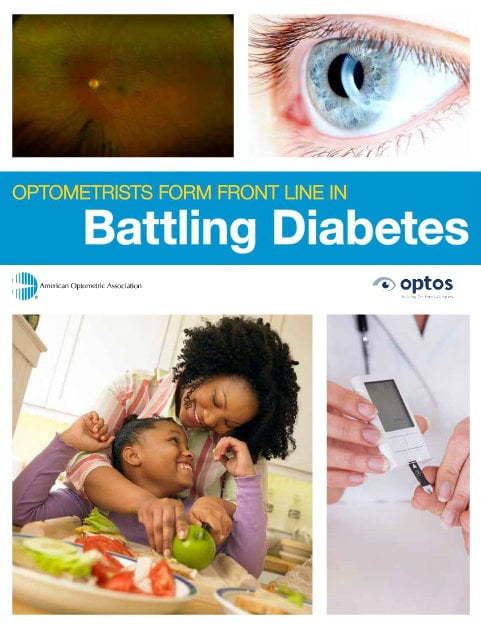With the leading cause of vision loss in American patients being attributed to diabetes, doctors of optometry are among the first line of defense against blindness caused by this disease. Collaborating with the American Optometric Association (AOA), Optos has sponsored a multi-year initiative focusing on clinical education and providing resources for diabetic patient care. One of these resources is the supplemental guide titled “Optometrists Form Front Line Battling Diabetes“.
This supplemental guide addresses the fact that as doctors of vision care, you are the primary caregivers to help prevent blindness due to diabetes, and ensuring visual and retinal health for your diabetic patients. The guide offers valuable information to help educate your patients on the possible repercussions diabetes can have on their eye health, and provide guidance to aid you in educating them on the importance of early detection, treatment and management of this disease.
The guide provides you not only with valuable advice in patient care, but also provides you with insight on how to educate your patients about preventative care and disease management to protect their eye health. Since the patient must be actively involved in their own care, there is even information on how to measure and bill for A1C, so you can monitor individual glucose control with your patients.
Despite the obesity epidemic and diabetes diagnoses in record numbers, improved imaging technologies and early detection practices has begin to decrease the occurrence of proliferative diabetic retinopathy, suggest several of the doctors who contributed to the supplemental guide. There are higher instances of general retinopathy, especially macular edema, however these anomalies are being diagnosed and treated much earlier than they have in the past.
Optos is committed to providing the technology for you to give patients a more thorough exam whether or not they suffer from diabetes. Our ultra-widefield retinal imaging technology lets you see and diagnose more without the need to dilate your patients’ eyes. Diagnostic images are immediately available for your perusal, and you can show your patients your concerns, as well as compare against past and future examinations. For more information, we invite you to visit our website or contact us.
